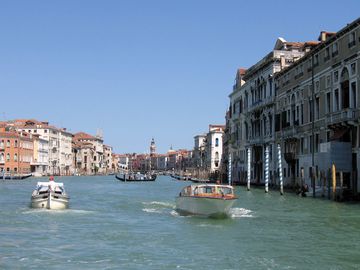

We are standing exactly in the middle of Venice's main transportation artery. The Grand Canal, however, is not only the city's central public and private thoroughfare, it is also a very romantic gallery that exhibits some of the most beautiful examples of Gothic, Renaissance and Baroque residential architecture. Finally, it is, and always will be, an inexhaustible source of inspiration for artists and writers coming from all over the world.
The Grand Canal starts by the tracks of the Santa Lucia train station and flows in the form of a reverse letter S down into the St. Mark's Basin in front of the Doge's Palace. It is 3,800 meters long and anywhere from 30 to 90 meters wide. Its average depth is five meters.
At least 170 palaces buttress the canal on both sides, demonstrating the wealth and creativity that Venice possessed in the days of the Most Serene Republic. Ca' Vendramin Calergi, Ca' Pesaro, Ca' d'Oro, Ca' Foscari, Ca' Rezzonico, and Ca' Dario are just a few of the most sensational buildings that can be found along the canal.
Four bridges cross the canal with the oldest being the Rialto, built in the 16th century. The Accademia Bridge by the Accademia Museum and the Scalzi Bridge by the train station were constructed in the 19th century. The last one, the Constitution Bridge, or the Calatrava, named after its Spanish architect connects the Piazzale Roma bus terminal with the train station. It was erected in 2008.
In the beginning, when Venetian civilization was just taking root, the people of the lagoon lived in stilt houses and their livelihood depended mainly on fishing and trading salt. At that time the canal was broader, flowing between small islets connected together by wooden bridges. Gradually, as the city grew, the canal witnessed the construction of sturdy waterfronts, created by wedging piles into the seabed and laying foundations upon them. As the merchant class accumulated wealth, the warehouses that they kept on the waterfronts were replaced by lavish palaces. Having a palace on the Grand Canal was a status symbol. At the height of the Venetian Republic, if your family did not have a palace on the Grand Canal, or anywhere near it, you would likely not be given much consideration.
Today the Grand Canal is a spectacular sight. Vessels of all sizes and style - vaporetti, taxis, private boats, gondolas - navigate back and forth, all day long, on the imperturbable waters of this ancient passage. Traffic has become so immense and the canal so congested, especially in the summer, that the local authorities often have difficulty managing the situation. In fact, in the summer of 2013 a gondola was crushed by a vaporetto, leading to a fatal accident involving one German tourist.
The greatest event on the Grand Canal is the Historical Regatta, a competition between teams representing Venice's six sestieri, that is, the six neighborhoods - Cannaregio, Santa Croce, San Polo, Dorsoduro, San Marco and Castello. The race is preceded by a historical procession honoring the return of the Queen of Cyprus, Caterina Cornaro, to Venice. Gondoliers, dressed in ceremonial costume, gallantly row their 16th century boats behind the doge's state galley, the Bucintoro. A ride down the Grand Canal is a must for any tourist, whether in a gondola or just in the vaporetto.